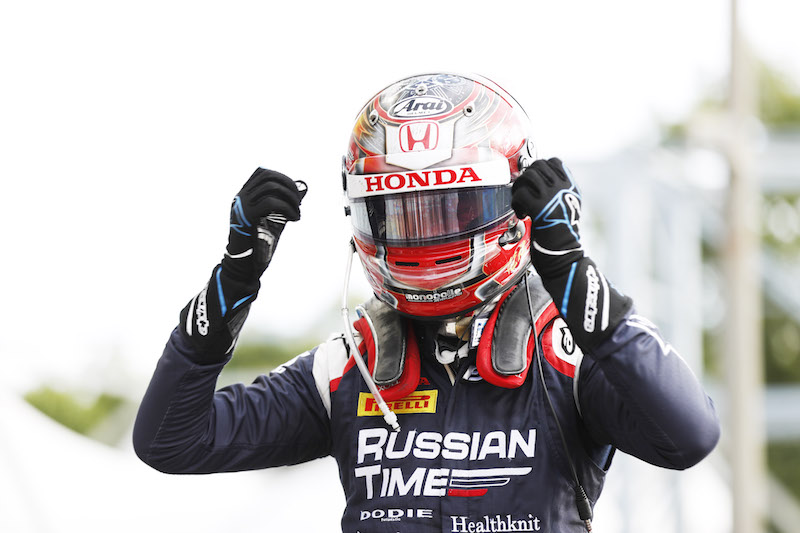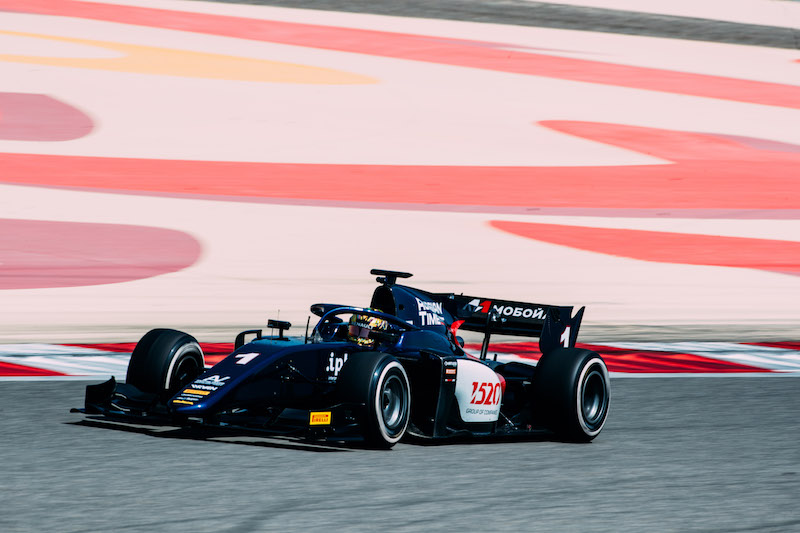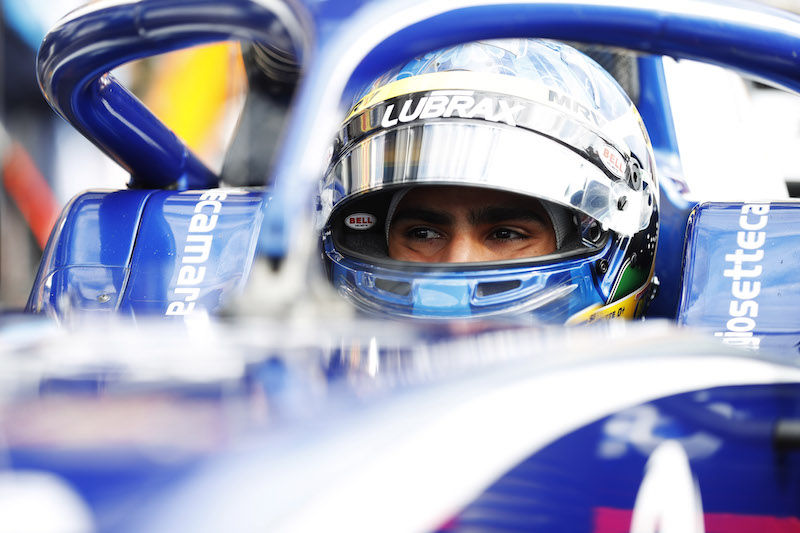
Photos: FIA F2 Media Service
Formula 1’s main feeder series brought in a new car for its second season since its rebranding as Formula 2, and the host of mechanical issues that came with it made it difficult to pick out the best performing drivers, particularly in the first half of the season.
The standings at the end of the season is arguably less representative than ever before, with the reliability issues that even resulted in races been started behind the safety car, and the obvious performance gaps between the teams.
However the star drivers were still able to shine through, and with the help of a deeper delve into the statistics, we pick out the top 10 stars of the 2018 season. One in which saw all of the top three secure full-time graduation to F1 for the following season for the first time since 2009.
Key Percentage of team’s points scored (TP%), Qualifying average (QA), Feature race average points (R1P), Sprint race average points (R2P)
10.?Nicholas Latifi?DAMS?9th in standings (1 win, 3 fastest laps, 3 podiums)
TP% – 30%, QA – 11th (12th best), R1P – 4.2 (9th best), R2P – 3.4 (9th best)

It took him a while – not helped by illness that hampered his pre-season – but once Latifi got up to speed with the new car, he wasn’t far off DAMS team-mate Alexander Albon, outqualifying him in two of the last three rounds, and completing a one-two for the team in the Sochi feature race. A couple of incidents, including an unlucky lap one incident with Alessio Lorandi in the Sochi sprint race, and stalling at Abu Dhabi from third on the grid grounded him to only ninth in the standings. Expect Latifi to repeat his 2017 performances in the championship next year.
9.?Tadasuke Makino?Russian Time?13th in standings (1 win)
TP% – 21%, QA – 11th (11th best), R1P – 3.7 (12th best), R2P – 0.3 (19th best)

Makino may have only been 13th in the standings, but he firmly deserved a place in the top 10. There were flashes of brilliance beyond his obvious shock Monza feature race win, having been thrown in at the deep end in F2 alongside series veteran Artem Markelov after a middling season in European Formula 3.
However, he earned his place almost instantly by qualifying eighth on his debut – Markelov was only 17th. His strong qualifying continued, with the intra-team qualifying battle ending as a dead heat after 12 rounds.
Although he couldn’t always string it together in the races and lacked the tyre expertise of his team-mate, this year provided a solid foundation year for making Makino one of Honda’s most exciting junior drivers, and his talents are likely to be more evident in Super Formula in 2019.
8.?Luca Ghiotto?Campos Racing?8th in standings (1 fastest lap, 4 podiums)
TP% – 84%, QA – 7th (6th best), R1P – 5.8 (8th best), R2P – 3.5 (8th best)

Ghiotto’s third year in F2 is statistically his worst but considering he was driving for a team that had a best finish of seventh in 2017, it would be harsh to write his season off. For a start, he had the sixth-best qualifying record, and his sharp racecraft earned him four podiums, including an excellent double podium at Paul Ricard. He also charged from 17th to third in the final feature race of the year at Abu Dhabi.
There were mistakes, however, such as the seemingly clumsy crash into the wall on the opening lap of the Baku feature race. Despite previous comments suggesting this season would be his last, a return to UNI-Virtuosi (the new name for Russian Time) in 2019 will surely be his last but best chance of title glory.
7.?Antonio Fuoco?Charouz Racing System?7th in standings (2 wins, 1 fastest lap, 6 podiums)
TP% – 66%, QA – 10th (9th best), R1P – 7.6 (7th best), R2P – 4.4 (7th best)

The Italian entered 2018 still slightly sore from his crushing defeat to team-mate and runaway champion Charles Leclerc last year. However, he led the charge for series debutant Charouz well, finishing on the podium six times including expertly-managed sprint race wins at Monaco and Abu Dhabi. Admittedly the first only came after a penalty for crashing out Ghiotto in the feature race put him on pole.
His one-lap speed is still a weakness, but his racecraft often helped him recover the lost ground, taking third from 12th on the grid in the Hungaroring feature race being a prime example.
6.?Artem Markelov?Russian Time?5th in standings (3 wins, 2 fastest lap, 7 podiums)
TP% – 79%, QA – 10th (10th best), R1P – 9.3 (6th best), R2P – 6.2 (3rd best)

The fears that Markelov had reached a glass ceiling during his excellent 2017 campaign were unfortunately true. His qualifying performances were an inconsistent mess and the mistakes in races were still present. However, he was still the same banzai, unpredictable Russian with exquisite racecraft and tyre management that turned up to then GP2 in 2014.
The season opener was the best example of this. He stole headlines away from a dominant Norris, with a superb charge to third place from 17th on the grid, then eased to victory in the reversed grid race from sixth. At the Red Bull Ring he surpassed this with a stunning triple overtake to secure sprint race pole. The next day he was atop the podium.
Markelov will be sorely missed in F2 next year.
5.?Nyck de Vries?Prema?4th in standings (3 wins, 2 poles, 4 fastest laps, 6 podiums)
TP% – 87%, QA – 5th (5th best), R1P – 9.6 (5th best), R2P – 5.3 (5th best)

Replacing outgoing champion Leclerc at Prema, de Vries must be disappointed to only finish fourth in his sophomore F2 campaign.
He began 2018 with a stuttering start, a podiumless season opener being followed by three errors at Baku (a misjudged move on leader George Russell), Barcelona (a spin) and Monaco (hitting Albon at the pit entrance), each costing potential victories.
Although he won consecutive feature races at the Hungaroring and Spa-Francorchamps, the errors and inconsistencies continued and he finished 85 points away from the title. A shame more than anything else, considering that when things were going right, de Vries was exceptionally good. His Hungaroring win in changing conditions was one of the best drives ever seen in GP2/F2. The infrequency of such performances has been an unfortunate trend in his career.
4.?Sergio Sette Camara?Carlin?6th in standings (1 pole, 3 fastest laps, 8 podiums)
TP% – 43%, QA – 5th (5th best), R1P – 9.6 (5th best), R2P – 5.3 (5th best)

In many ways, Sette Camara is very similar to de Vries. His final points tally and position fails to be representative of the performance he had. Sette Camara is higher in our ranking, despite the fewer points, because of why so many points were lost.
In his case, it was far more frequently down to sheer bad fortune or unreliability. The most obvious example was the hand injury he sustained at Monaco, which put him out of the weekend. He would have started the feature race in fourth place, and considering the Albon/de Vries crash, the Brazilian would have fancied his chances of victory.
There was also the disqualification from second place at Baku for not having enough fuel, qualifying troubles which cost him a podium at Barcelona, and a potential podium in the Silverstone feature race lost to mechanical issues.
Sette Camara was more than a match in speed for the highly-rated Norris, and a good third F2 season with DAMS next year could provide the springboard for the Brazilian to join him on the F1 grid soon.
3.?Lando Norris?Carlin?2nd in standings (1 win, 1 pole, 1 fastest lap, 9 podiums)
TP% – 57%, QA – 5th (3rd best), R1P – 10.4 (4th best), R2P – 6.7 (2nd best)

Norris defied expectations by not winning the title this year, despite starting in the best possible fashion. The dominant Bahrain win from pole position proved to be the peak of his season, and was historically a mighty feat for the then 18-year-old. The tricky Hungaroring feature race, where he equalled de Vries’ brilliance, was the only other time he led a race.
He was beaten by primary title rival Russell in every other feature race bar Baku, Monaco and Hungary, where Russell was struck by misfortune, and being outperformed that frequently meant the title was not a realistic prospect by the second half of the season.
But let those facts not detract from what was a deeply impressive rookie season. He qualified in the top eight 11 times out of 12, completed more laps than any other driver and scored the second most amount of points in the sprint races – regularly showing his superior racecraft and pulling off some bold overtaking manoeuvres, such as his brilliant double manoeuvre on Markelov and de Vries at at Silverstone or his getting by both Albon and Deletraz in one corner at Abu Dhabi.
2.?Alexander Albon?DAMS?3rd in standings (4 wins, 3 poles, 8 podiums)
TP% – 70%, QA – 4th (2nd best), R1P – 11.8 (2nd best), R2P – 4.8 (6th best)

Bad luck and Albon seemed to walk hand in hand at times, but despite the numerous knocks he was consistently able to produce great results and earned Formula E and F1 races drives, a situation which seemed very unlikely after his disappointing rookie 2017 season.
The switch from ART to DAMS paid dividends, and he was consistently Russell’s main challenger, only losing second in the points due to an unusually poor Abu Dhabi weekend.
Albon, once runner-up to Leclerc in GP3, took three consecutive poles in the first half of the year, but a woeful race start in Spain and the aforementioned de Vries crash in Monaco prevented Albon from racing into an early points lead.
Engine trouble in Paul Ricard then doomed him to playing catch up for the rest of the year. His luck reversed at Silverstone, when a slow Russell pitstop handed him the win, while his Sochi victory was surely among his season highlights, as was going around the outside of Ghiotto at Turn 1 to win the Hungaroring sprint race.
1.?George Russell?ART Grand Prix?1st in standings (7 wins, 5 poles, 5 fastest laps, 11 podiums)
TP% – 82%, QA – 2nd (best on grid), R1P – 14.1 (best on grid), R2P – 8.2 (best on grid)

Every year the bar seems to be raised for F2 champions. Stoffel Vandoorne and Leclerc both won seven races in 2015 and ’17 seasons, and Russell equalled that tally in 2018. But what he achieved beyond that was arguably even more impressive.
Take a look at his qualifying record. Five pole positions, seven front-row starts, and the only time he qualified outside of the top four was in Monaco, where engine trouble limited his running.
He was also held back by clutch failure at the Hungaroring, an over-ambitious de Vries in Baku as well as sensor issues at Paul Ricard. His eventual 68-point victory margin would have been even greater.
He also faced opposition that was arguably stronger than Vandoorne or Leclerc’s, but still averaged 3.7 more points than closest rival Norris every race, as well as qualifying position 2.4/three positions better than his fellow Englishman.
Russell continued to show his ruthless side when fighting for championships, demonstrating few examples of holding back or losing his nerve, just as with his first single-seater title in BRDC British Formula 4 in 2014. When there was a sniff of success, Russell rose to the occasion and made sure he was the man to beat. Expect him to impress in F1 next year.
Just missing out
Charouz’s Louis Deletraz narrowly missed out on a place in our top 10. He made a marked improvement on his tricky debut season, with impressive one-lap pace giving him a better qualifying average than team-mate Fuoco, but he struggled for consistency in the races, only making the podium in two sprint races.
Jack Aitken was beaten by ART team-mate Russell in all areas. However, he still showed his raw potential with an excellent sprint race win at a wet Barcelona. Even more impressive was the way he recovered from stalling on the formation lap to take second place in the Baku feature race. His head seemed to drop when Russell began dominating the field, and he never really recovered.
It’s difficult to assess Arden duo?Maximilian Gunther and Nirei Fukuzumi. Ending 14th and 17th in the points can surely not be representative of the former European F3 and GP3 title contenders, as the team clearly struggled. Gunther was the better of the two, with a qualifying average three places better. They scored the same amount of points in feature races, but Gunther outscored Fukuzumi by 24 points on Sundays, largely helped by winning at Silverstone.
Roberto Merhi was solid in the 10 rounds he took part in, taking two podiums, including MP Motorsport’s only one of the season. He believed he would’ve been top five in the standings had he done the whole year with late-season partner Campos.?Arjun Maini was also solid if unspectacular, aside from his great weekend in Monaco. Clearly disrupted by team-mate’s Santino Ferrucci’s actions and engine issues, he struggled to 16th in the standings, while his team Trident picked up the wooden spoon for the second consecutive year.
